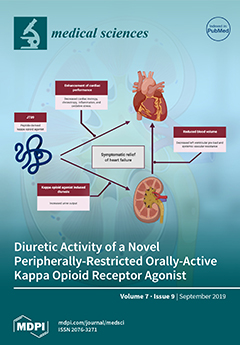Kappa-opioid agonists (KOAs) enhance cardiac performance, as well as reduce infarct size and prevent deleterious cardiac remodeling following myocardial infarction. Additionally, KOAs promote diuresis; however, there has been limited development of KOAs as a class due to the promotion of untoward central
[...] Read more.
Kappa-opioid agonists (KOAs) enhance cardiac performance, as well as reduce infarct size and prevent deleterious cardiac remodeling following myocardial infarction. Additionally, KOAs promote diuresis; however, there has been limited development of KOAs as a class due to the promotion of untoward central nervous system (CNS)-mediated side effects. Our laboratory has developed a peripherally-restricted, orally-active, KOA (
JT09) for the treatment of pain and cardiovascular disease. Peripherally-restricted KOAs possess a limited side-effect profile and demonstrate potential in preventing heart failure. The aim of this study was to assess the diuretic activity of lead compound
JT09 relative to vehicle control and Tolvaptan through single oral administration to adult male Sprague–Dawley rats.
JT09-administered rats demonstrated significantly increased urine output relative to vehicle control. However, the effect persisted for 8 h, whereas Tolvaptan-administered rats demonstrated diuretic activity for 24 h. Relative to Tolvaptan, urine output was significantly reduced in
JT09 administered animals at all-time points, suggesting that the overall diuretic effect of
JT09 is less profound than Tolvaptan. Additionally,
JT09-administered rats demonstrated alterations in clinical chemistry; reduced urine specific gravity; and increased urine pH relative to vehicle control. The following study establishes a preliminary diuretic profile for
JT09.
Full article





